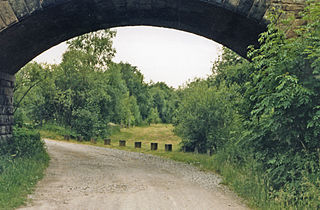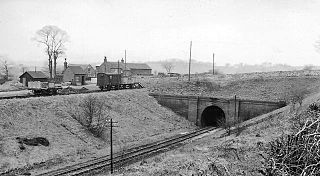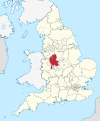Re-opening, and the Churnet Valley Railway
During the 1970s a railway preservation base was set up at nearby Cheddleton station. This was later to become the base of the Churnet Valley Railway. The CVR had been slowly progressing in preserving the line when in the late 1990s they had reached the station site.
The down (western) platform was still in existence but without any platform edging stones. These were replaced and this platform opened for passengers 11 July 1998. Construction later began on the replica station buildings which opened on 3 March 2002.
The second track running through the station, which had served as a run-round loop, was made redundant when the line was extended to Froghall, so work began on resignalling this loop to allow two train operation on the line. This involved the addition of signals and a signal box to the station (the original line was double track throughout, so no box was ever located at Consall).
To finish, the wooden up (eastern) platform was reconstructed so that the original 1902 shelter could be put back into use and so passing trains had a platform to call in the up direction.
This platform was opened on 22 April 2005 and now the station is relatively complete and is the nerve centre of train operations on peak days due to the new passing loop and signal box.

The North Staffordshire Railway (NSR) was a British railway company formed in 1845 to promote a number of lines in the Staffordshire Potteries and surrounding areas in Staffordshire, Cheshire, Derbyshire and Shropshire.

The Churnet Valley Railway is a preserved standard gauge heritage railway to the east of Stoke-on-Trent in Staffordshire, England, that operates along a part of the former North Staffordshire Railway's (NSR) Churnet Valley Line. Regular services travel between the two main stations at Cheddleton and Kingsley and Froghall. There is an intermediate station at Consall. Most trains also head beyond Cheddleton to Leek Brook Junction and on to Ipstones, but Ipstones station is not in use.
The Stafford and Uttoxeter Railway was authorised by Act of Parliament on 29 July 1862, to build a line between the towns in its title, in Staffordshire, England. It opened for traffic in 1867. It was nicknamed the Clog and Knocker. It opened on 23 December 1867. Construction cost had much exceeded estimates, and income was poor, so that the Company was always in financial difficulty. It was placed in receivership in 1875. The Great Northern Railway (GNR) had running powers to Uttoxeter and was persuaded to acquire the Company, which it did in 1881. The GNR spent a considerable sum on improving the line, but it never made money and it was closed to passengers on 4 December 1939. Goods traffic ceased in 1951, except for a short stub to RAF Stafford; this too closed in 1975.

Uttoxeter railway stationpronounced (listen) (help·info) in Uttoxeter, Staffordshire, England, is served by trains on the Crewe-Derby Line, which is also a Community rail line known as the North Staffordshire line. The station is owned by Network Rail and managed by East Midlands Railway. The full range of tickets for travel are purchased from the guard on the train at no extra cost since there are no retail facilities at this station. It is the closest railway station to Alton Towers to which it is linked by a semi-regular bus service. A taxi rank also exists just next to the station.
Kingsley and Froghall railway station is a former railway station of the North Staffordshire Railway (NSR) that is now a preserved station on the Churnet Valley Railway in Staffordshire, England.

Cheddleton railway station is a former passenger railway station of the North Staffordshire Railway (NSR) and is now a preserved station on the Churnet Valley Railway in Staffordshire, England].

Leek Brook railway station is a passenger station in Staffordshire, Great Britain.

Alton Station, previously called Alton railway station and Alton Towers railway station, is holiday accommodation and an abandoned railway station in Staffordshire, managed by the Landmark Trust. Opened in 1849 by the North Staffordshire Railway, the station was part of the Churnet Valley line and served the village of Alton and the country estate at Alton Towers. In 1954, the station was renamed Alton Towers. After being closed in 1965, Alton Towers was purchased by Staffordshire County Council in 1969 to curtail persistent vandalism of the station building, and in 1979 was sold to the Landmark Trust, who renamed the site to Alton Station and converted the former station buildings into holiday accommodation.
The Cheadle branch line was a railway line of just under 4 miles (6.4 km) in length that served the town of Cheadle, Staffordshire. It was in operation as a passenger line from 1892 to 1963, and closed altogether in 1986. It took 46 years from conception to completion and was notable in that part of the line had to be practically rebuilt partway through its existence.

Rocester railway station was a railway station built by the North Staffordshire Railway (NSR) located at Rocester in Staffordshire.

Egginton Junction railway station is a disused railway station in Egginton, Derbyshire.

Denstone railway station is a former station of the North Staffordshire Railway's (NSR) Churnet Valley Line which served the village of Denstone in Staffordshire.
The Churnet Valley line was one of the three original routes planned and built by the North Staffordshire Railway. Authorised in 1846, the line opened in 1849 and ran from North Rode in Cheshire to Uttoxeter in East Staffordshire. The line was closed in several stages between 1964 and 1988 but part of the central section passed into the hands of a preservation society and today operates as the Churnet Valley Railway.

Cliffe Park railway station was opened by the North Staffordshire Railway (NSR) in 1905 on the Churnet Valley line to attract visitors to Rudyard Lake, which the NSR were trying to develop as a leisure and tourist attraction including a golf course. The station was originally named Rudyard Lake and was at the northern end of the lake. There were no settlements nearby and consequently the station had no goods facilities. There was one siding but this was used more for stabling excursion trains rather than freight vehicles.
Rudyard railway station served Rudyard, Staffordshire and was opened by the North Staffordshire Railway (NSR) in 1850 on the Churnet Valley line. In the village the NSR also owned the Rudyard Hotel as part of the company's efforts to develop Rudyard Lake and its environs as a tourist destination.
Waterhouses railway station was a railway station that served the village of Waterhouses, Staffordshire. It was opened jointly by the North Staffordshire Railway (NSR) and the Leek and Manifold Valley Light Railway (L&MVLR) in 1905 and closed in 1943.
The St Edward's Hospital tramway was a tramway built for Staffordshire County Council for the construction of the St Edward's County Mental Asylum at Cheddleton, Staffordshire. Opened in 1899, the line ran until 1954 before being closed and scrapped.
Ipstones railway station was a railway station that served the village of Ipstones, Staffordshire. It was opened by the North Staffordshire Railway (NSR) in 1905 and closed to passenger use in 1935, but remained open to freight traffic until 1964.

Bradnop railway station was a railway station that served the village of Bradnop, Staffordshire. It was opened by the North Staffordshire Railway (NSR) in 1905 and closed to passenger use in 1935, but remained open to freight traffic until 1964.
The Waterhouses branch line was a railway built by the North Staffordshire Railway to link the small villages east of Leek, Staffordshire with Leek, the biggest market town in the area. The railway opened in 1905 but closed to passengers in 1935. Freight continued on the line though until 1988, when the line was mothballed as the traffic from the quarries at Caldon Low ceased.












